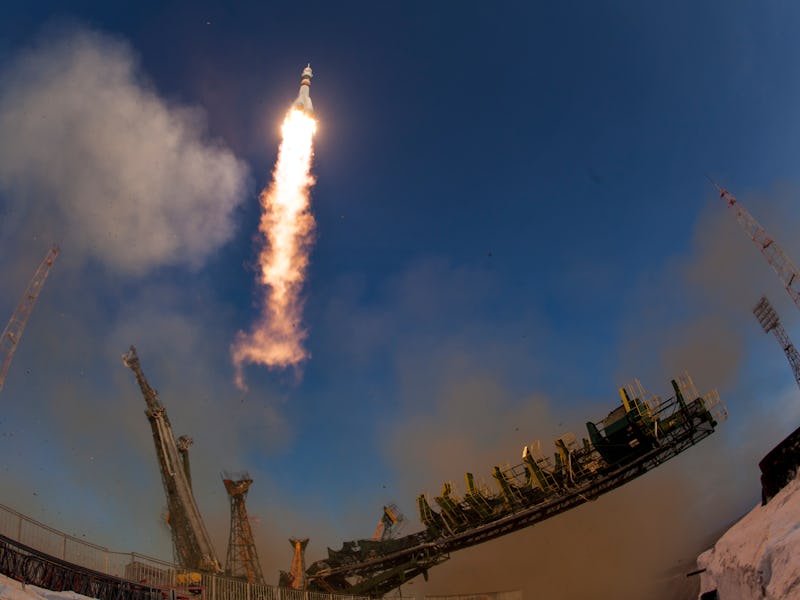Jeff Bezos: Computer Simulations Will Reduce "Test-Fail-Fix Loop" for BE-4 Engine
The Blue Engine 4 should be ready by 2019.

Blue Origin chief Jeff Bezos offered an update today about the aerospace company’s development of its BE-4 combustion rocket engine, which will eventually eliminate America’s reliance on the Russian-made engines it currently uses.
In an email this morning to members of the Blue Origin listserv, Bezos announced that BE-4 combustion simulations in which unburned oxygen is introduced into the gas stream to keep things from overheating were progressing well. To keep everything nice and steady, Bezos & co. are using 3D Computational Fluid Dynamics, a recent development for chemical physics. According to Bezos, CFD predicts the behavior or the liquid oxygen combustion using Navier-Stokes equations — describing the interrelationships of the fluid’s velocity, pressure, temperature, and density.
“The ability to do combusting CFD simulations doesn’t eliminate the need for rigorous testing, but it will significantly shorten the test-fail-fix loop on the test stand,” Bezos writes.
The BE-4, slated for use in Blue Origin’s rockets by 2019, will power the United Launch Alliance’s in-development Vulcan rocket. ULA is in competition with SpaceX to carry private and governmental payloads like satellites and supplies to the International Space Station.
Blue Origin has a deal with the ULA in which both parties jointly fund development of the BE-4.
This engine will power the Vulcan rocket once it's complete
“To date, we’ve completed several million core hours of CFD modeling of BE-4 combustion processes,” Bezos writes in today’s update. “Modeling of the preburner shows good mixing and temperature uniformity upstream of the turbine. The combustion and temperature data we’ve gathered in our subscale testing correlate with our CFD predictions and show that our preburner sizing and injector element design meet design requirements. The ability to do combusting CFD simulations doesn’t eliminate the need for rigorous testing, but it will significantly shorten the test-fail-fix loop on the test stand. We’ll keep you updated.”
BE-4 is quite the coup for Bezos in terms of limiting our dependence on Russian technology to power rockets; most of our engines come from there, including the technology the ULA currently uses. Once the BE-4 is complete, Bezos and Blue Origin will have yet another edge in his perpetual battle with SpaceX and its CEO, rival Elon Musk.
Here’s the full text of Bezos’s email:
In the BE-4 preburner, a very small portion of the engine’s liquefied natural gas (LNG) fuel mixes and burns with all of the engine’s liquid oxygen to produce hot gaseous oxygen, which is used to drive the turbine and spin the turbopumps. Oxygen and LNG burn stoichiometrically above 6,000 degrees Fahrenheit, and temperatures of about 3,000 degrees Fahrenheit or more are needed to reliably ignite and sustain the reaction. No practical turbine materials would survive at that temperature, especially in a reusable application. To resolve this, the BE-4 preburner mixes unburned oxygen into the burned gas stream to dilute the combustion gases and reduce the overall temperature to about 700 degrees Fahrenheit. If this mixing process isn’t meticulously designed, hot spots can persist in the stream and limit turbine life.
To design the preburner to provide uniform temperature, we use 3-D Computational Fluid Dynamics (CFD) to model the LNG and liquid oxygen combustion process. CFD predicts fluid behavior by solving the Navier-Stokes equations to describe how the velocity, pressure, temperature, and density of a moving fluid relate. CFD of reacting flows, especially those that also involve a phase change, is much, much harder because it must also solve chemistry along with state equations. Combusting CFD has only become practical with recent advances in chemical physics models and computing power.
To date, we’ve completed several million core hours of CFD modeling of BE-4 combustion processes. Modeling of the preburner shows good mixing and temperature uniformity upstream of the turbine. The combustion and temperature data we’ve gathered in our subscale testing correlate with our CFD predictions and show that our preburner sizing and injector element design meet design requirements. The ability to do combusting CFD simulations doesn’t eliminate the need for rigorous testing, but it will significantly shorten the test-fail-fix loop on the test stand. We’ll keep you updated.
Gradatim Ferociter!
Jeff Bezos